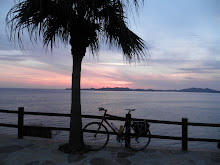Be warned that camping near a temple means that at 5am there will be lots of bells, visitors and general noise to wake you up if you're not already awake out of discomfort.
 So an early start to the day, which is perfect for seeing Matsuyama castle with only the early morning joggers. Another stunning castle set amidst the cherry blossom.
So an early start to the day, which is perfect for seeing Matsuyama castle with only the early morning joggers. Another stunning castle set amidst the cherry blossom.Still early in the day, so I make a stop at Dogo onsen. Its nice to spend some time in this city. When I cycled around the 88 temples of Shikoku I didn't stop at the castle or onsen, but that was mainly due to the huge queues of over an hour to get into the baths as it was golden week.
I broke another spoke in the rear wheel overnight, so I find another super helpful bike mechanic at Umezawa, its here if you need a bike shop in Matsuyama.
 One more trip to Ishiteji (temple #51), this is one of the more impressive and memorable temples on the meguri.
One more trip to Ishiteji (temple #51), this is one of the more impressive and memorable temples on the meguri. I meet a French ohenro san in the grounds, he's walked the Santiago de Compostela pilgrimage before, there seems to be a link between the two walks.
Matsuyama is probably my favourite town in Shikoku, but its soon time to move on and this time I take the hilly option along 317 instead of the coastal route over to Imabari. Lakes, cherry blossom and good climbing make this much more interesting than another flat ride along the coast. As I approach the tunnel at the top of the climb, I catch another cyclist on a Trek 7.3fx, except his is blue. We say hello and I tell hime where I'm going, then he takes off while I set up my lights for the tunnel. A long long descent, and my weight eventually pays off as I catch and pass him once more. At a junction I stop and ponder the map and he stops to tell me the route once more. I was expecting to camp near the same onsen by the michi no eki, several km south of Imabari. But this time, he insists I stay at his house in Imabari, and its not such a difficult decision after sleeping on the carpark last night.
His wife prepares the meal while we go by car to the same onsen I visited 2 years ago, it is a decent place to visit in this area.
 We are later joined by his son and grandchildren, neighbours for a generous feast of sashimi, great salad and much sake and shochu meal. Great opportunity to use my yakusugi sake cups and flask for the first time! I never quite worked out if this meal was already planned or the gathering was for my benefit, but it was a fun night.
We are later joined by his son and grandchildren, neighbours for a generous feast of sashimi, great salad and much sake and shochu meal. Great opportunity to use my yakusugi sake cups and flask for the first time! I never quite worked out if this meal was already planned or the gathering was for my benefit, but it was a fun night. Ueoka san is also a cycling henro. His job is sailing the ferry from Hiroshima to Matsuyama, and in summer he cycles to the ferry port.
In general, his hospitality sums up the spirit of the people in Kyushu and Shikoku who I met along the way. So many people were waving, offering me fruit on the route or schoolgirls trying to take their photo with me made it all seem very special and a world away even from Tokyo.
The next morning after breakfast Ueoka san rode out to the start of the Shimanamikaido where we said our final sayonaras. I really appreciate his "O-settai" (gift for ohenro san), I must remember to send a new years card to the family this year.
So the final stage of my tour was about to start, the Shimanami kaido (Island wave route) Its a series of 6 islands connected by impressive bridges connecting Shikoku to the mainland of Honshu. Its an interesting route, very popular with cyclists as theres over 60km of cyclepath which is very unusual for Japan and of course its all pretty scenic. The ride itself is not so tough, and the incredibly gentle gradients of the bridges make it not so exciting as you don't go so fast on the descents and the climbs are almost too tediously gentle. At times I was very tempted to take the shorter, steeper paths for mopeds, but avoided them only as I might end up on a completely different track.
As the km markers counted down to virtually zero, I realised that the final section of water to cross was not going to be by bridge, but by ferry! Almost felt robbed here, as cycling is not allowed on the final (or first) bridge.
Its a nice way to get to or from Shikoku, so as part of a long tour its definitely an interesting day on the bike, but probably not worth going out there just to do the ride. But that all depends on where you're coming from, and where you're going to.






































